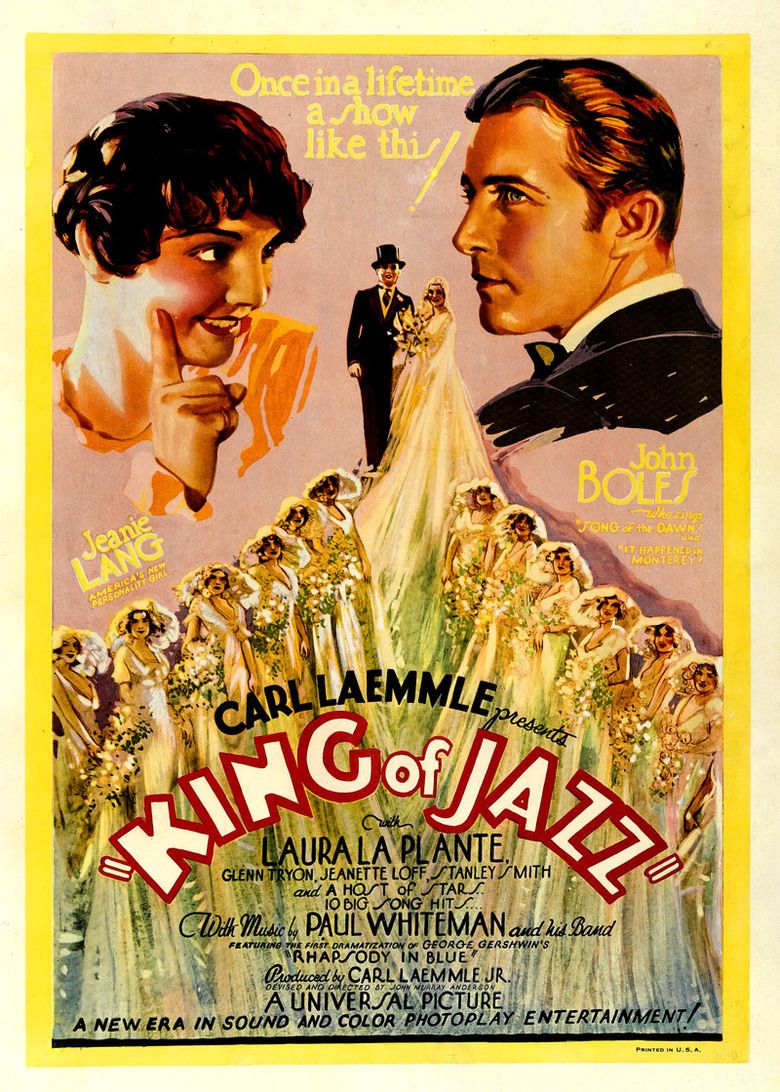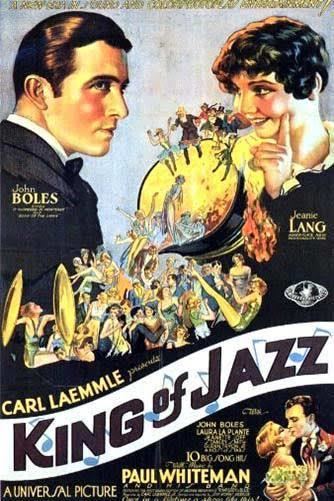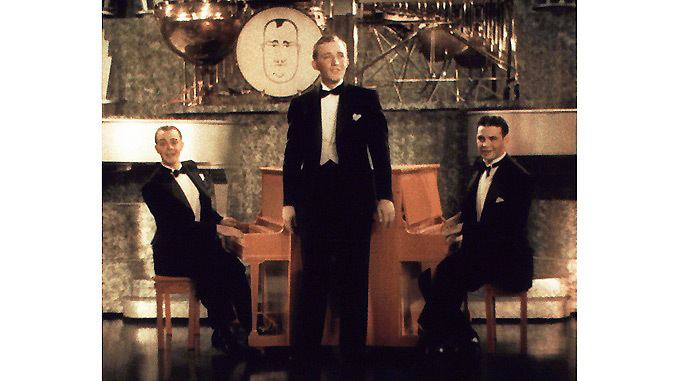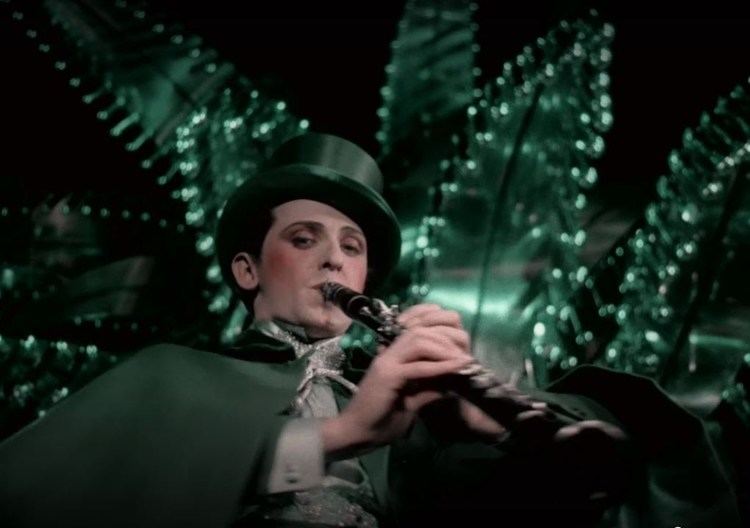King of Jazz
7.8 /10 1 Votes7.8
Duration Country United States | 7.6/10 IMDb Genre Animation, Music Language English | |||||||||||||||||||||||||||||||||
 | ||||||||||||||||||||||||||||||||||
Director John Murray AndersonPal Fejos (uncredited) Release date April 19, 1930 (1930-04-19) Screenplay Charles MacArthur, Harry Ruskin Cast (Paul Whiteman), (Vocalist ('Song of the Dawn' / 'It Happened in Monterey')), (Editor ('Ladies of the Press') / Stenographer ('In Conference') / Quartet Member, 'Nellie'), (Vocalist ('It Happened in Monterey' / 'Bridal Veil' / 'A Bench in the Park')), Glenn Tryon (Executive ('In Conference') / Unmarried Husband), William Kent (General ('All Noisy on the Eastern Front') / Goldfish Owner ('Oh! Forevermore!') / Unmarried Couple's Offspring / Vocal ('Do Things For You'))Similar movies Stormy Weather (1943) | ||||||||||||||||||||||||||||||||||
King of jazz 1930 restored technicolor sequence
King of Jazz is a 1930 American Pre-Code color film starring Paul Whiteman and his orchestra. The film title was taken from Whiteman's self-conferred appellation. At the time the film was made, "jazz", to the general public, meant the jazz-influenced syncopated dance music which was being heard everywhere on phonograph records and through radio broadcasts. In the 1920s Whiteman signed and featured white jazz musicians including Joe Venuti and Eddie Lang (both are seen and heard in the film), Bix Beiderbecke (who had left before filming began), Frank Trumbauer and others.
Contents
- King of jazz 1930 restored technicolor sequence
- King of jazz happy feet
- The film
- The cartoon
- Soundtrack
- The Rhythm Boys
- Release
- Reception
- References

King of Jazz was filmed entirely in the early two-color Technicolor process and was produced by Carl Laemmle Jr. for Universal Pictures. The movie featured several songs sung on camera by the Rhythm Boys (Bing Crosby, Al Rinker and Harry Barris), as well as off-camera solo vocals by Crosby during the opening credits and, very briefly, during a cartoon sequence. King of Jazz still survives in a near-complete color print and is not a lost film, unlike many contemporary musicals that now exist only either in incomplete form or as black-and-white reduction copies.

In 2013 the film was selected for preservation in the United States National Film Registry by the Library of Congress as being "culturally, historically, or aesthetically significant".

King of jazz happy feet
The film

King of Jazz is a revue. There is no story, only a series of musical numbers alternating with "blackouts" (very brief comedy sketches with abrupt punch line endings) and other short introductory or linking segments.

The musical numbers are diverse in character, taking a "something for everyone" approach to appeal to family audiences by catering to the young, the old and the middle-aged in turn. The slow Bridal Veil number, featuring (according to Universal) the largest veil ever made, exhibits Victorian sentimentality that might best appeal to the elderly. The middle-aged was courted with a tune by John Boles in a lush setting crooning It Happened in Monterey in waltz time, or in a barn with a chorus of red-shirted ranch hands belting out the Song of the Dawn. The "jazzy" Happy Feet number was designed to appeal to younger audiences.

One segment early in the film serves to introduce several of the band's virtuoso musicians (yet those musicians are not credited by name). Another provides the audience with a chance to see the Rhythm Boys, already famous by sound but not sight because of their recordings and radio broadcasts, performing in a home-like setting. There are novelty and comedy numbers ranging from the mildly risqué (Ragamuffin Romeo, which features contortionistic dancing that provides an excuse for intimate views of frilly underwear) to the humorously sadomasochistic (the second chorus of I Like to Do Things for You) to the simply silly (I'm a Fisherman). There is a line of chorus girls, practically mandatory in early musicals, but in their featured spot the novelty is that they are seated.

The grand finale is the Melting Pot number, in which various immigrant groups in national costume offer brief renditions of characteristic songs from their native lands, after which they are all consigned to the American Melting Pot. Performers from some of the earlier musical numbers briefly reprise their acts while reporting for duty as fuel under the pot. Whiteman stirs the steaming stew. When the cooking is complete, everyone emerges transformed into a jazz-happy American.

There are a couple of early examples of the overhead views later elaborated and made famous by Busby Berkeley, but this film bears little resemblance to his films and other musicals of the later 1930s. It is very much a stage presentation, albeit on a very large stage, and visual interest is maintained only by changes of viewpoint. The cameras do not move. This is not because the Technicolor cameras were heavy and bulky. The cameras used for this early Technicolor process contained a single roll of film and were of nearly ordinary size and weight.

King of Jazz was the nineteenth all-talking motion picture filmed entirely in two-color Technicolor rather than simply including color sequences. At the time, Technicolor's two-color process employed red and green dyes, each with a dash of other colors mixed in, but no blue dye. King of Jazz was to showcase a spectacular presentation of George Gershwin's Rhapsody in Blue, so this presented a problem. Fortunately, the green dye Technicolor used can actually appear peacock blue (cyan) under some conditions, but acceptable results in this case would require very careful handling. Art director Herman Rosse and production director John Murray Anderson came up with solutions. Tests were made of various fabrics and pigments, and by using an all gray-and-silver background the bluish aspect of the dye was set off to best advantage. Filters were also used to inject pale blues into the scene being filmed. The goal was to produce a finished film with pastel shades rather than bright colors. Nevertheless, as it appears in an original two-color Technicolor print, the sequence might best be described as a "Rhapsody in Turquoise". Later prints made from the original two-component negative, which had survived, make the blues look truer and more saturated than they appeared to audiences in 1930.
King of Jazz marked the first film appearance of the popular crooner Bing Crosby, who, at the time, was a member of The Rhythm Boys, the Whiteman Orchestra's vocal trio. Crosby was scheduled to sing "Song of the Dawn" in the movie but a motor accident led to him being jailed for a time and the song was given to John Boles.
Composer Ferde Grofé, best known for his Grand Canyon Suite, was in his early years a well known arranger/songwriter for Whiteman. He is documented to have arranged some of the music, and may in fact have composed some of the incidental music.
The film preserves a vaudeville bit by Whiteman band trombonist Wilbur Hall, who does novelty playing on violin and bicycle pump, as well as the eccentric dancing of "Rubber Legs" Al Norman to the tune of Happy Feet.
There were at least nine different foreign language versions of the film. Reportedly, the Swedish version has at least some different music.
The cartoon
The movie included the first Technicolor animated cartoon segment, by animators Walter Lantz (later famous for Woody Woodpecker and other characters) and William Nolan. In this cartoon, Whiteman is hunting "in darkest Africa", where he is chased by a lion which he soothes by playing a tune on a violin (Music Hath Charms, played by Joe Venuti and Eddie Lang). After an elephant squirts water on a monkey in a tree, the monkey throws a coconut at the elephant. It misses and hits Whiteman on the head. The bump on his head forms into a crown. Master of Ceremonies Charles Irwin then remarks, "And that's how Paul Whiteman was crowned the King of Jazz."
One of the characters making a brief appearance in the cartoon is Oswald the Lucky Rabbit, the star of the Universal Studios animation department led by Lantz. A black-and-white sound cartoon featuring Oswald, titled My Pal Paul, also released in 1930 by Universal, promoted King of Jazz by including songs from the movie and a cartoon Paul Whiteman character.
Some of the scenes from the animated cartoon sequence would be later re-used for a later Walter Lantz Oswald Cartoon, Africa.
Soundtrack
King of Jazz was the first feature-length film to use a mostly pre-recorded soundtrack made independently of the actual filming. Whiteman insisted that musical numbers featuring his orchestra should be pre-recorded in order to obtain the best sound, avoiding the poor recording conditions and extraneous noises typical of a movie studio sound stage. Universal opposed the idea, but Whiteman prevailed over the reluctant studio executives. After the sound was recorded, it was played back through a loudspeaker while the scene was being filmed and the performers matched their actions to the recording. Later, the resulting film was synchronized with the soundtrack. This also allowed the scene to be shot in the same manner as a silent film, with the director free to shout out instructions during the filming and the camera unrestricted by any need to silence its noises with bulky soundproofing.
Delbert Cobain, one of the singers in the film, is notable as being the great-uncle of musician Kurt Cobain.
The Rhythm Boys
The Rhythm Boys (Bing Crosby, Harry Barris, and Al Rinker) sang Mississippi Mud, So the Bluebirds and the Blackbirds Got Together, I'm a Fisherman, A Bench in the Park, and Happy Feet in the film. This singing trio also recorded as part of Whiteman's band and on their own with Barris on piano. Crosby also sang Music Hath Charms over the title credits and provided the singing voice for Whiteman in the animated cartoon singing My Lord Deliver Daniel.
Release
The film debuted on April 19, 1930 at the Criterion Theater in Los Angeles. Box-office receipts at this theater were below expectations within the first two weeks.
A grand premiere was held on May 2, 1930 at the Roxy Theater in New York City, where the Whiteman Orchestra, together with George Gershwin and the 125-piece Roxy Symphony Orchestra, put on a stage show. It featured the Rhapsody in Blue and Mildred Bailey backed by the Roxy Chorus and was performed five times a day, between showings of the film, for a week. The film continued to play at the Roxy for only one additional week.
As originally released, the film was 105 minutes long. The 1933 reissue was 65 minutes. Several entire sequences and numbers were removed for the reissue, while others were trimmed of just a few shots. One cut for the 1933 re-release was a sketch with William Kent about a suicidal flute player, with the Whiteman Orchestra performing Caprice Viennois as background music.
The 2016 restoration runs 98 minutes with two minutes of playout music. Some sections were cut before the film's 1930 release and never seen by the general public. They include:
A 93 minute version, cobbled together from the 65 minute negative and a 16 mm print was used for the videocassette release of the film in 1983. Prints of the original uncut version still survive. As of September 18, 2017, there has been no authorized release of any version of the film on DVD.
Reception
Universal expected this revue to repeat or surpass the box-office performance of a musical entitled Broadway which it had released in 1929. That lavish film had included Technicolor sequences and had been a success. Unfortunately, delays in beginning the actual filming of King of Jazz caused its release to occur after two unforeseen developments. First, the public had tired of the flood of movie musicals that began as a slow trickle with The Jazz Singer in late 1927 and rapidly became a torrent after the success of The Broadway Melody in early 1929. In particular disfavor were operettas set in bygone eras, musical-comedies which were unimaginatively filmed Broadway stage productions, and plotless "revues" such as King of Jazz. Second, although the ripple effects from the stock market crash in October 1929 had not yet produced the full-blown depression which would soon be painfully obvious, people were already spending less freely and the effects were starting to be felt at the box-office. During its national release, King of Jazz cleared less than $900,000. Around Hollywood, the movie came to be called "Universal's Rhapsody in the Red". Because of poor box-office receipts for the film and the cancellation of his lucrative nationally-broadcast radio program by its sponsor in April 1930, Whiteman had to let ten bandmembers go and cut the salaries of the remaining bandmembers by fifteen percent.
After the film's release, a reviewer for The New Movie wrote:
A disappointment—but a lavish one. An over-produced revue. Universal called in Murray Anderson, a foot-light revue producer, and let him run riot with an unfamiliar medium. The result is a dull mélange of tremendous sets, dancing girls, and indifferent principals, save for Paul Whiteman, who registers. The color photography, too, is bad, keeping events in vague semi-darkness. Jeanette Loff looks beautiful but falls down vocally. John Boles scores briefly (with "It Happened in Monterey") and everyone else is buried in the extravagance of scenery. This picture cost $2,000,000 to make—and is miles too long.
Overseas, where there was never a backlash against musicals, it fared better and eventually made a profit. During the 1930s, the film found its best audience in Cape Town, South Africa, where it played seventeen return engagements.
The film won an Academy Award for Best Art Direction by Herman Rosse. Other films nominated in this category were Bulldog Drummond, The Love Parade, Sally and The Vagabond King.
The film is recognized by American Film Institute in the following lists:
References
King of Jazz WikipediaKing of Jazz IMDb King of Jazz themoviedb.org
